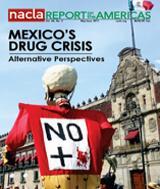Report
@font-face {
font-family: "Times New Roman";
}@font-face {
font-family: "Cambria";
}@font-face {
font-family: "BaileySansITC-BookItalic";
}p.MsoNormal, li.MsoNormal, div.MsoNormal { margin: 0in 0in 10pt; font-size: 12pt; font-family: Cambria; }table.MsoNormalTable { font-size: 10pt; font-family: "Times New Roman"; }p.TOCBlurb, li.TOCBlurb, div.TOCBlurb { margin: 0in 0in 9pt; line-height: 12pt; font-size: 10pt; font-family: BaileySansITC-BookItalic; color: black; font-style: italic; }div.Section1 { page: Section1; }
The small-time traffickers of the Altar Desert try to legitimize themselves as heirs to an idealized ranchero tradition. Trafficking provides a modest subsidy, allowing them to avoid migrating and to maintain otherwise unprofitable ranches.
The roots of the drug war run deep in Mexico, perhaps deeper than in the United States. If we seek to achieve a moral revolution against prohibitionism, it must take place on both sides of the Rio Grande.
@font-face {
font-family: "Times New Roman";
}@font-face {
font-family: "Cambria";
}@font-face {
font-family: "BaileySansITC-BookItalic";
}p.MsoNormal, li.MsoNormal, div.MsoNormal { margin: 0in 0in 10pt; font-size: 12pt; font-family: Cambria; }table.MsoNormalTable { font-size: 10pt; font-family: "Times New Roman"; }p.TOCBlurb, li.TOCBlurb, div.TOCBlurb { margin: 0in 0in 9pt; line-height: 12pt; font-size: 10pt; font-family: BaileySansITC-BookItalic; color: black; font-style: italic; }div.Section1 { page: Section1; }
On Mexico’s newsstands, one will easily find two kinds of images: the latest scenes of carnage from the drug war and half-naked women. Sex and violence in the media isn’t new, but in this case, fantasy serves to mask the country’s real violence.
@font-face {
font-family: "Times New Roman";
}@font-face {
font-family: "Cambria";
}@font-face {
font-family: "BaileySansITC-BookItalic";
}p.MsoNormal, li.MsoNormal, div.MsoNormal { margin: 0in 0in 10pt; font-size: 12pt; font-family: Cambria; }table.MsoNormalTable { font-size: 10pt; font-family: "Times New Roman"; }p.TOCBlurb, li.TOCBlurb, div.TOCBlurb { margin: 0in 0in 9pt; line-height: 12pt; font-size: 10pt; font-family: BaileySansITC-BookItalic; color: black; font-style: italic; }div.Section1 { page: Section1; }
The constant images of death in the Mexican media serve as propaganda to justify military and police deployments. The violence has become a kind of insidious marketing campaign for the very policy that unleashes the violence.
@font-face {
font-family: "Times New Roman";
}@font-face {
font-family: "Cambria";
}@font-face {
font-family: "BaileySansITC-BookItalic";
}p.MsoNormal, li.MsoNormal, div.MsoNormal { margin: 0in 0in 10pt; font-size: 12pt; font-family: Cambria; }table.MsoNormalTable { font-size: 10pt; font-family: "Times New Roman"; }p.TOCBlurb, li.TOCBlurb, div.TOCBlurb { margin: 0in 0in 9pt; line-height: 12pt; font-size: 10pt; font-family: BaileySansITC-BookItalic; color: black; font-style: italic; }div.Section1 { page: Section1; }
The ultra-violence that plagues Ciudad Juárez, home to perhaps the world’s highest homicide rate, began in 2008, when President Felipe Calderón deployed thousands of soldiers and federal police to fight the cartels.
Elaine Carey and José Carlos Cisneros Guzmán
@font-face {
font-family: "Times New Roman";
}@font-face {
font-family: "Cambria";
}@font-face {
font-family: "BaileySansITC-BookItalic";
}p.MsoNormal, li.MsoNormal, div.MsoNormal { margin: 0in 0in 10pt; font-size: 12pt; font-family: Cambria; }table.MsoNormalTable { font-size: 10pt; font-family: "Times New Roman"; }p.TOCBlurb, li.TOCBlurb, div.TOCBlurb { margin: 0in 0in 9pt; line-height: 12pt; font-size: 10pt; font-family: BaileySansITC-BookItalic; color: black; font-style: italic; }div.Section1 { page: Section1; }
The stories of four Mexican women working in the drug trade echo that of Ignacia “La Nacha” Jasso, who controlled much of the Ciudad Juárez drug market beginning in the 1920s.
@font-face {
font-family: "Times New Roman";
}@font-face {
font-family: "Cambria";
}@font-face {
font-family: "BaileySansITC-BookItalic";
}p.MsoNormal, li.MsoNormal, div.MsoNormal { margin: 0in 0in 10pt; font-size: 12pt; font-family: Cambria; }table.MsoNormalTable { font-size: 10pt; font-family: "Times New Roman"; }p.TOCBlurb, li.TOCBlurb, div.TOCBlurb { margin: 0in 0in 9pt; line-height: 12pt; font-size: 10pt; font-family: BaileySansITC-BookItalic; color: black; font-style: italic; }div.Section1 { page: Section1; }
Beto, a 16-year-old hit man for La Familia Michoacana, one of the most notoriously violent Mexican drug gangs, tells his story.

